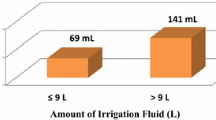Abstract
Objectives
The objectives were to evaluate haemodynamic, electrolyte and metabolic changes in patients undergoing percutaneous nephrolithotomy when normal saline was used for irrigation; and to correlate these changes with irrigation time, volume of irrigation fluid absorbed and number of percutaneous interventions.
Methods
Twenty adults undergoing percutaneous nephrolithotomy were studied. Heart rate, systolic and diastolic blood pressure, arterial blood gases, electrolytes and temperature were monitored before, during and after irrigation. Haemoglobin, urea and creatinine values were recorded before and 24 h after the procedure. Durations of anaesthesia and irrigation; volumes of irrigation fluid used and effluent fluid; and number of percutaneous interventions during the procedure were also recorded.
Results
No significant changes occurred in mean heart rate, systolic and diastolic blood pressure, electrolytes, haemoglobin, urea and creatinine. There was a significant fall in mean pH in post-operative period (P = 0.003) and bicarbonate values showed a negative correlation with duration of irrigation. Number of percutaneous interventions had positive correlations with duration of irrigation and volume of irrigant fluid absorbed.
Conclusions
No significant changes occurred in haemodynamics and electrolytes, but there was a trend towards metabolic acidosis. Arterial blood gases should be monitored during and after PCNL in cases with prolonged irrigation time, repeated percutaneous interventions and patients having compromised renal function and metabolic status.
Similar content being viewed by others
References
Alken P, Hutschenreiter G, Gunther R, Marberger M (1981) Percutaneous stone manipulation. J Urol 125:463–466
Sinclair JF, Hutchison A, Baraza R, Telfer AB (1985) Absorption of 1.5% glycine after percutaneous ultrasonic lithotripsy for renal stone disease. Br Med J 291:691–692
Dimberg M, Norlen H, Hoglund N, Allgen LG (1993) Absorption of irrigating fluid during percutaneous transrenal lithotripsy. Scand J Urol Nephrol 27:463–467
Malhotra SK, Khaitan A, Goswami AK et al (2001) Monitoring of irrigation fluid absorption during percutaneous nephrolithotripsy: the use of 1% ethanol as a marker. Anaesthesia 56:1090–1115
Atici S, Zeren S, Aribogan A (2001) Hormonal and hemodynamic changes during percutaneous nephrolithotomy. Int Urol Nephrol 32:311–314
Koroglu A, Togal T, Cicek M et al (2003) The effects of irrigation fluid volume and irrigation time on fluid electrolyte balance and hemodynamics in percutaneous nephrolithotripsy. Int Urol Nephrol 35:1–6
Gehring H, Nahm W, Zimmermann K et al (1999) Irrigating fluid absorption during percutaneous nephrolithotripsy. Acta Anaesthesiol Scand 43:316–321
Badawy H, Salama A, Eissa M et al (1999) Percutaneous management of renal calculi: Experience with percutaneous nephrolithotomy in 60 children. J Urol 162:1710–1713
Author information
Authors and Affiliations
Corresponding author
Rights and permissions
About this article
Cite this article
Mohta, M., Bhagchandani, T., Tyagi, A. et al. Haemodynamic, electrolyte and metabolic changes during percutaneous nephrolithotomy. Int Urol Nephrol 40, 477–482 (2008). https://doi.org/10.1007/s11255-006-9093-6
Received:
Accepted:
Published:
Issue Date:
DOI: https://doi.org/10.1007/s11255-006-9093-6




